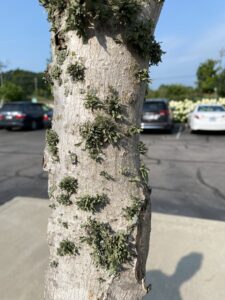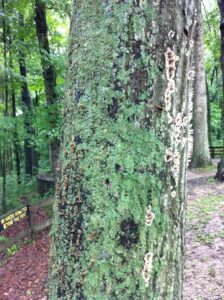Each year, several calls and emails express concern or interest regarding this “strange growth” on my tree. Does it mean my tree is dying? Should I spray something to kill it?
The answer is “No”.
Trees can have a partnership with lichen (pronounced “liken”) basically anywhere on the tree. This interesting organism can be found on trunks and branches alike. The key thing to remember, they are not and do not cause disease problems. They exist on the tree to only to obtain sunlight and can grow rapidly when exposed to full sun conditions. In addition to growing on tree parts, lichens can be found in just about any suitable environment including dead wood, rocks, soil, or just about any place they can obtain sun.
Lichen species are an extraordinary organism because it consists of two unrelated organisms, an alga and a fungus. These two components coexist as a single organism creating a symbiotic relationship. The alga, because it is a green plant, can photosynthesize and provide energy for the lichen. The fungus contributes to the relationship by obtaining water and minerals and by protecting the algal cells from desiccation. The fungus and the alga when working together make up what is known as the lichen thallus.
The color and form of this growth is often used to group and classify the lichens. The most common species of lichens on trees tend to be a gray-green color, but other species may be orange, yellow, slate blue, or black.
- Example of crustose lichen.
- Example of foliose lichen
There are three major growth forms of lichens: foliose, fruticose, and crustose. Foliose lichens have leaf-like lobes. These are the gray-green structures that can often be seen growing on tree trunks or branches. They are slightly raised and can grow and coalesce with other lichen thalli, covering several inches or more of bark. If moistened, they become somewhat rubbery and can be removed. Fruticose lichens have hair- like or stringy thalli and are less common. Finally, as the name implies, crustose lichens have crust-like thalli. Crustose lichens can often be found tightly embedded on rocks or lower tree trunks. (Rocks with lichens are used to add interest to rock gardens.)
Don’t be alarmed if you see them on your trees or anywhere in the urban forest because they are an important part of the ecosystem and can tell a story. Lichens need clean, fresh air to survive. As an organism they can absorb everything beneficial nutrients to harmful toxins. They especially like to absorb water in the air, which is why so many are found in damper areas along lakes and streams or other water sources.
Look around the big cities of the world. What do you see? Not very many lichens, that’s for sure. Very few lichens can survive near factories, next to highways, and other sources of pollution. Because lichens are extremely sensitive to air pollution, their absence can be used to indicate poor air quality or excessive air pollutants. In fact, some research indicates the various forms of lichen can help in identification of the type of possible pollution sources and their origin. So, don’t get alarmed about it, just start taking a little “lichen” to it.


